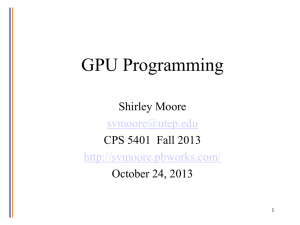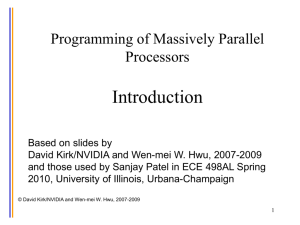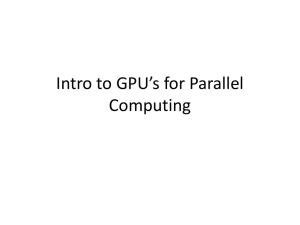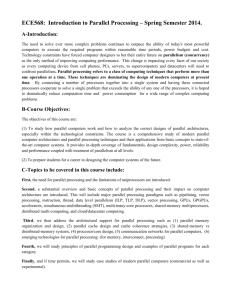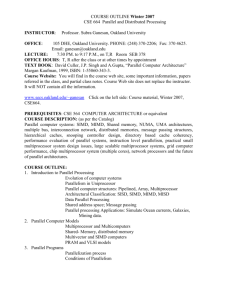CS6963 Parallel Programming for Graphics
advertisement
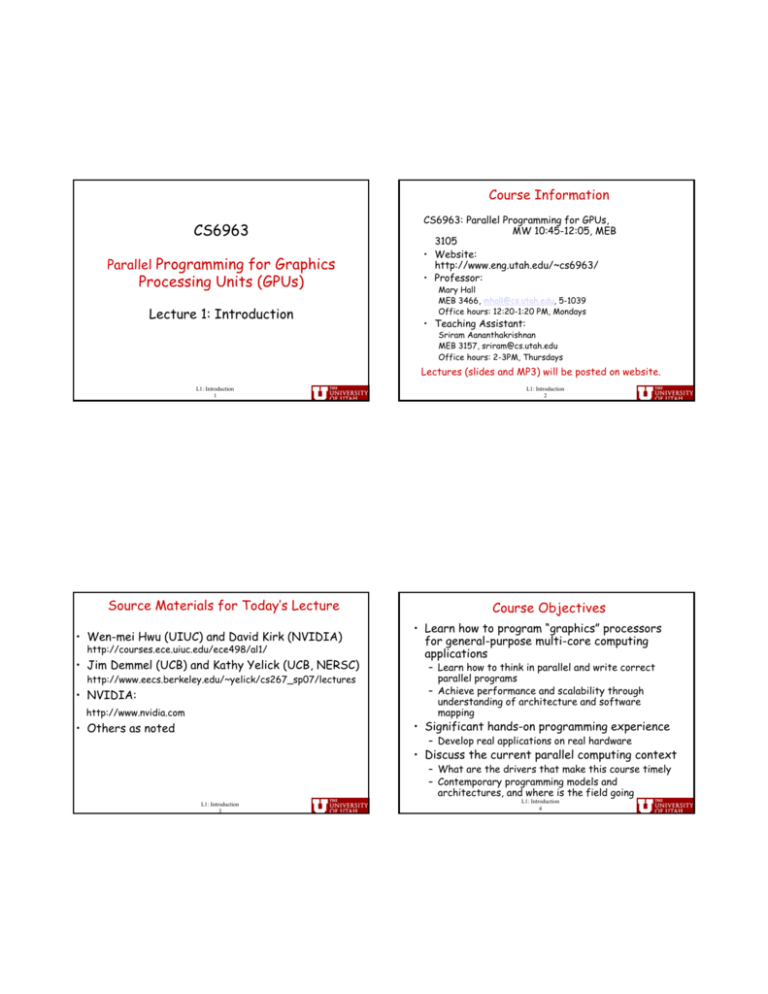
Course Information CS6963 Parallel Programming for Graphics Processing Units (GPUs) Lecture 1: Introduction CS6963: Parallel Programming for GPUs, MW 10:45-12:05, MEB 3105 • Website: http://www.eng.utah.edu/~cs6963/ • Professor: Mary Hall MEB 3466, mhall@cs.utah.edu, 5-1039 Office hours: 12:20-1:20 PM, Mondays • Teaching Assistant: Sriram Aananthakrishnan MEB 3157, sriram@cs.utah.edu Office hours: 2-3PM, Thursdays Lectures (slides and MP3) will be posted on website. L1: Introduction 1 Source Materials for Today’s Lecture • Wen-mei Hwu (UIUC) and David Kirk (NVIDIA) http://courses.ece.uiuc.edu/ece498/al1/ • Jim Demmel (UCB) and Kathy Yelick (UCB, NERSC) http://www.eecs.berkeley.edu/~yelick/cs267_sp07/lectures • NVIDIA: http://www.nvidia.com L1: Introduction 2 Course Objectives • Learn how to program “graphics” processors for general-purpose multi-core computing applications – Learn how to think in parallel and write correct parallel programs – Achieve performance and scalability through understanding of architecture and software mapping • Significant hands-on programming experience • Others as noted – Develop real applications on real hardware • Discuss the current parallel computing context – What are the drivers that make this course timely – Contemporary programming models and architectures, and where is the field going L1: Introduction 3 L1: Introduction 4 Grading Criteria • • • • • • • Homeworks and mini-projects: Midterm test: Project proposal: Project design review: 10% Project presentation/demo Project final report Class participation Primary Grade: Team Projects 25% 15% 10% 15% 20% 5% • Some logistical issues: – 2-3 person teams – Projects will start in late February • Three parts: – (1) Proposal; (2) Design review; (3) Final report and demo • Application code: – Most students will work on MPM, a particle-in-cell code. – Alternative applications must be approved by me (start early). L1: Introduction 5 Collaboration Policy • I encourage discussion and exchange of information between students. • But the final work must be your own. – Do not copy code, tests, assignments or written reports. – Do not allow others to copy your code, tests, assignments or written reports. L1: Introduction 6 Lab Information Primary lab • “lab6” in WEB 130 • Windows machines • Accounts are supposed to be set up for all who were registered as of Friday • Contact opers@eng.utah.edu with questions Secondary • Until we get to timing experiments, assignments can be completed on any machine running CUDA 2.0 (Linux, Windows, MAC OS) Tertiary • Tesla S1070 system expected soon L1: Introduction 7 L1: Introduction 8 Text and Notes 1. 2. 3. 4. NVidia, CUDA Programmng Guide, available from http://www.nvidia.com/object/cuda_develo p.html for CUDA 2.0 and Windows, Linux or MAC OS. [Recommended] M. Pharr (ed.), GPU Gems 2 – Programming Techniques for High Performance Graphics and General-Purpose Computation, Addison Wesley, 2005. http://http.developer.nvidia.com/GPUGems2/gpug ems2_part01.html [Additional] Grama, A. Gupta, G. Karypis, and V. Kumar, Introduction to Parallel Computing, 2nd Ed. (Addison-Wesley, 2003). Additional readings associated with lectures. L1: Introduction 9 Today’s Lecture • Overview of course (done) • Important problems require powerful computers … – … and powerful computers must be parallel. – Increasing importance of educating parallel programmers (you!) • Why graphics processors? • Opportunities and limitations • Developing high-performance parallel applications – An optimization perspective L1: Introduction 11 Schedule: A Few Make-up Classes A few make-up classes needed due to my travel Time slot: Friday, 10:45-12:05, MEB 3105 Dates: February 20, March 13, April 3, April 24 L1: Introduction 10 Parallel and Distributed Computing • Limited to supercomputers? – No! Everywhere! • Scientific applications? – These are still important, but also many new commercial applications and new consumer applications are going to emerge. • Programming tools adequate and established? – No! Many new research challenges My Research Area L1: Introduction 12 Scientific Simulation: The Third Pillar of Science • Why we need powerful computers Traditional scientific and engineering paradigm: 1) Do theory or paper design. 2) Perform experiments or build system. • Limitations: – – – – • Too Too Too Too difficult -- build large wind tunnels. expensive -- build a throw-away passenger jet. slow -- wait for climate or galactic evolution. dangerous -- weapons, drug design, climate experimentation. Computational science paradigm: 3) Use high performance computer systems to simulate the phenomenon • Base on known physical laws and efficient numerical methods. L1: Introduction 13 Slide source: Jim Demmel, UC Berkeley The quest for increasingly more powerful machines • Scientific simulation will continue to push on system requirements: – To increase the precision of the result – To get to an answer sooner (e.g., climate modeling, disaster modeling) • The U.S. will continue to acquire systems of increasing scale L1: Introduction 14 A Similar Phenomenon in Commodity Systems • • • • • More capabilities in software Integration across software Faster response More realistic graphics … – For the above reasons – And to maintain competitiveness L1: Introduction 15 L1: Introduction 16 Technology Trends: Moore’s Law Transistor count still rising Clock speed flattening sharply Why powerful computers must be parallel Slide from Maurice Herlihy L1: Introduction 17 L1: Introduction 18 Techology Trends: Power Issues Power Perspective 1000000000 100000000 10000000 100000 10000 Performance (Gflops) Power 1000 100 10 1 1960 0.1 1970 1980 1990 2000 0.01 0.001 Slide source: Bob Lucas From www.electronics-cooling.com/.../jan00_a2f2.jpg L1: Introduction 19 L1: Introduction 20 2010 2020 MegaWatts GigaFlop/s 1000000 Who Should Care About Performance Now? The Multi-Core Paradigm Shift What to do with all these transistors? • Key ideas: • Everyone! (Almost) – Sequential programs will not get faster – Movement away from increasingly complex processor design and faster clocks – Replicated functionality (i.e., parallel) is simpler to design – Resources more efficiently utilized – Huge power management advantages All Computers are Parallel Computers. • If individual processors are simplified and compete for shared resources. • And forget about adding new capabilities to the software! – Parallel programs will also get slower • Quest for coarse-grain parallelism at odds with smaller storage structures and limited bandwidth. – Managing locality even more important than parallelism! • Hierarchies of storage and compute structures • Small concession: some programs are nevertheless fast enough L1: Introduction 21 L1: Introduction 22 Why Massively Parallel Processor • A quiet revolution and potential build-up – – – Calculation: 367 GFLOPS vs. 32 GFLOPS Memory Bandwidth: 86.4 GB/s vs. 8.4 GB/s Until last year, programmed through graphics API GeForce 8800 16 highly threaded SM’s, >128 FPU’s, 367 GFLOPS, 768 MB DRAM, 86.4 GB/S Mem BW, 4GB/S BW to CPU Host Input Assembler GFLOPS Thread Execution Manager G80 = GeForce 8800 GTX Parallel Data Cache Parallel Data Cache Parallel Data Cache Parallel Data Cache Parallel Data Cache Parallel Data Cache Parallel Data Cache Parallel Data Cache G71 = GeForce 7900 GTX Texture Texture Texture Texture Texture Texture Texture Texture Texture G70 = GeForce 7800 GTX NV40 = GeForce 6800 Ultra NV35 = GeForce FX 5950 Ultra – NV30 = GeForce FX 5800 GPU in every PC and workstation – massive volume and potential impact © David Kirk/NVIDIA and Wen-mei W. Hwu, 2007 ECE 498AL, University of Illinois, Urbana-Champaign L1: Introduction 23 Load/store Load/store Load/store Load/store Global Memory © David Kirk/NVIDIA and Wen-mei W. Hwu, 2007 ECE 498AL1, University of Illinois, Urbana-Champaign Load/store Load/store Concept of GPGPU (General-Purpose Computing on GPUs) • Idea: • Potential for very high performance at low cost • Architecture well suited for certain kinds of parallel applications (data parallel) • Demonstrations of 30-100X speedup over CPU • Early challenges: – Architectures very customized to graphics problems (e.g., vertex and fragment processors) – Programmed using graphics-specific programming models or libraries • Recent trends: – Some convergence between commodity and GPUs and their associated parallel programming models L1: Introduction 25 Stretching Traditional Architectures • Traditional parallel architectures cover some super-applications – DSP, GPU, network apps, Scientific, Transactions • The game is to grow mainstream architectures “out” or domain-specific architectures “in” – CUDA is latter © David Kirk/NVIDIA and Wen-mei W. Hwu, 2007 ECE 498AL, University of Illinois, Urbana-Champaign 27 See http://gpgpu.org L1: Introduction 26 The fastest computer in the world today RoadRunner • What is its name? • Where is it located? Los Alamos National Laboratory ~19,000 processor chips • How many processors does it (~129,600 “processors”) have? • What kind of processors? AMD Opterons and IBM Cell/BE (in Playstations) • How fast is it? 1.105 Petaflop/second One quadrilion operations/s 1 x 1016 See http://www.top500.org L1: Introduction 28 Parallel Programming Complexity An Analogy to Preparing Thanksgiving Dinner • Enough parallelism? (Amdahl’s Law) – Suppose you want to just serve turkey • Granularity – How frequently must each assistant report to the chef • After each stroke of a knife? Each step of a recipe? Each dish completed? All of these things makes parallel – Grab the spices one at a time? Or collect ones that are needed programming prior to startingeven a dish? harder than sequential – What if you have to go to the grocery store while cooking? programming. Finding Enough Parallelism • Suppose only part of an application seems parallel • Amdahl’s law – let s be the fraction of work done sequentially, so (1-s) is fraction parallelizable – P = number of processors • Locality <= 1/(s + (1-s)/P) • Load balance – Each assistant gets a dish? Preparing stuffing vs. cooking green beans? • Coordination and Synchronization 1-s Speedup(P) = Time(1)/Time(P) s <= 1/s • Even if the parallel part speeds up perfectly, performance is limited by the sequential part – Person chopping onions for stuffing can also supply green beans – Start pie after turkey is out of the oven L1: Introduction 29 Overhead of Parallelism • Given enough parallel work, this is the biggest barrier to getting desired speedup • Parallelism overheads include: – cost of starting a thread or process – cost of communicating shared data – cost of synchronizing – extra (redundant) computation • Each of these can be in the range of milliseconds (=millions of flops) on some systems • Tradeoff: Algorithm needs sufficiently large units of work to run fast in parallel (I.e. large granularity), but not so large that there is not enough parallel work L1: Introduction 31 L1: Introduction 30 Locality and Parallelism Conventional Storage Proc Hierarchy Cache L2 Cache (Device) Grid Block (0, 0) Block (1, 0) Shared Memory Host + GPU Storage Hierarchy L3 Cache Host Memory Registers Registers Shared Memory Registers Registers Thread (0, 0) Thread (1, 0) Thread (0, 0) Thread (1, 0) Local Memory Local Memory Local Memory Local Memory Global Memory Constant Memory Texture Memory • Large memories are slow, fast memories are small • Storage hierarchies are large and fast on average • Algorithm should do most work on nearby data L1: Introduction 32 Courtesy NVIDIA Load Imbalance • Load imbalance is the time that some processors in the system are idle due to – insufficient parallelism (during that phase) – unequal size tasks • Examples of the latter – different control flow paths on different tasks – adapting to “interesting parts of a domain” – tree-structured computations – fundamentally unstructured problems • Algorithm needs to balance load Summary of Lecture • Technology trends have caused the multi-core paradigm shift in computer architecture – Every computer architecture is parallel • Parallel programming is reaching the masses – This course will help prepare you for the future of programming. • We are seeing some convergence of graphics and general-purpose computing • Graphics processors can achieve high performance for more general-purpose applications • GPGPU computing – Heterogeneous, suitable for data-parallel applications L1: Introduction 33 Next Time • Immersion! – Introduction to CUDA L1: Introduction 35 L1: Introduction 34


